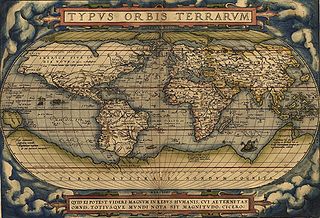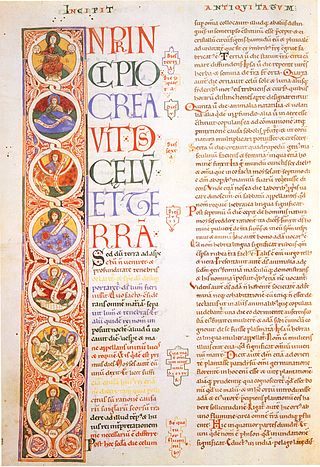
The Renaissance is a period in history and a cultural movement marking the transition from the Middle Ages to modernity, covering the 15th and 16th centuries and characterized by an effort to revive and surpass the ideas and achievements of classical antiquity; it was associated with great social change in most fields and disciplines, including art, architecture, politics, literature, exploration and science. It began in the Republic of Florence, then spread to the rest of Italy and later throughout Europe. The term rinascita ("rebirth") first appeared in Lives of the Artists by Giorgio Vasari, while the corresponding French word renaissance was adopted into English as the term for this period during the 1830s.

Abraham Ortelius was a cartographer, geographer, and cosmographer from Antwerp in the Spanish Netherlands. He is recognized as the creator of the first modern atlas, the Theatrum Orbis Terrarum. Along with Gemma Frisius and Gerardus Mercator, Ortelius is generally considered one of the founders of the Netherlandish school of cartography and geography. He was a notable figure of this school in its golden age and an important geographer of Spain during the age of discovery. The publication of his atlas in 1570 is often considered as the official beginning of the Golden Age of Netherlandish cartography. He was the first person proposing that the continents were joined before drifting to their present positions.

Theatrum Orbis Terrarum is considered to be the first true modern atlas. Written by Abraham Ortelius, strongly encouraged by Gillis Hooftman and originally printed on 20 May 1570 in Antwerp, it consisted of a collection of uniform map sheets and supporting text bound to form a book for which copper printing plates were specifically engraved. The Ortelius atlas is sometimes referred to as the summary of sixteenth-century cartography. The publication of the Theatrum Orbis Terrarum (1570) is often considered as the official beginning of the Golden Age of Netherlandish cartography.

John Amos Comenius was a Moravian philosopher, pedagogue and theologian who is considered the father of modern education. He served as the last bishop of the Unity of the Brethren before becoming a religious refugee and one of the earliest champions of universal education, a concept eventually set forth in his book Didactica Magna. As an educator and theologian, he led schools and advised governments across Protestant Europe through the middle of the seventeenth century.

Antiquities of the Jews is a 20-volume historiographical work, written in Greek, by historian Josephus in the 13th year of the reign of Roman emperor Domitian, which was 94 CE. The book contains an account of the history of the Jewish people for Josephus's gentile patrons. In the first ten volumes, Josephus follows the events of the Hebrew Bible beginning with the creation of Adam and Eve.
The names used for some major European cities differ in different European and sometimes non-European languages. In some countries where there are two or more languages spoken, such as Belgium or Switzerland, dual forms may be used within the city itself, for example on signage. This is also the case in Ireland, despite a low level of actual usage of the Irish language. In other cases where a regional language is officially recognised, that form of the name may be used in the region, but not nationally. Examples include the Welsh language in Wales in the United Kingdom, and parts of Italy and Spain.
The names used for some major European cities differ in different European and sometimes non-European languages. In some countries where there are two or more languages spoken, such as Belgium or Switzerland, dual forms may be used within the city itself, for example on signage. This is also the case in Ireland, despite a low level of actual usage of the Irish language. In other cases where a regional language is officially recognised, that form of the name may be used in the region, but not nationally. Examples include the Welsh language in Wales in the United Kingdom, and parts of Italy and Spain.
The names used for some major European cities differ in different European and sometimes non-European languages. In some countries where there are two or more languages spoken, such as Belgium or Switzerland, dual forms may be used within the city itself, for example on signage. This is also the case in Ireland, despite a low level of actual usage of the Irish language. In other cases where a regional language is officially recognised, that form of the name may be used in the region, but not nationally. Examples include the Welsh language in Wales in the United Kingdom, and other languages in parts of Italy and Spain.

Genealogia deorum gentilium, known in English as On the Genealogy of the Gods of the Gentiles, is a mythography or encyclopedic compilation of the tangled family relationships of the classical pantheons of Ancient Greece and Rome, written in Latin prose from 1360 onwards by the Italian author and poet Giovanni Boccaccio.

The Thomas-Institut is a research Institute whose function is to study of medieval philosophy by preparing critical editions as well as historical and systematic studies of medieval authors.

Encyclopedias have progressed from the beginning of history in written form, through medieval and modern times in print, and most recently, displayed on computer and distributed via computer networks.
Johann Georg Theodor Grässe was a German bibliographer and literary historian. He worked in Dresden at the Münzkabinett and also edited the journal Zeitschrift für Museologie und Antiquitätenkunde. He was born in Grimma and died in Niederlössnitz.
Leuphana (Λευφάνα) is a city name, first mentioned by Ptolemy in the year 150 in the Atlas Geographia.







